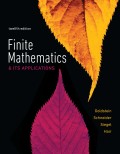
Concept explainers
An urn contains four red balls and six white balls. Suppose that two balls are drawn at random from the urn, and let X be the number of red balls drawn. The probability of obtaining two red balls depends on whether the balls are drawn with or without replacement. The purpose of this project is to show that the expected number of red balls drawn is not affected by whether or not the first ball is replaced before the second ball is drawn. The idea for this project was taken from the article “An Unexpected Expected Value,” by Stephen Schwartzman, which appeared in the February 1993 issue of The Mathematics Teacher.
Do you think that the expected number of red balls drawn is higher if the balls are drawn with replacement or without replacement?
Want to see the full answer?
Check out a sample textbook solution
Chapter 7 Solutions
Finite Mathematics & Its Applications (12th Edition)
Additional Math Textbook Solutions
Elementary Statistics
College Algebra (7th Edition)
Probability And Statistical Inference (10th Edition)
Graphical Approach To College Algebra
Elementary Statistics: A Step By Step Approach
Intermediate Algebra (13th Edition)
- pls helparrow_forwardx The function f is shown below. If I is the function defined by g(x) = √ ƒ(t) dt, find the value of g"(-8) in simplest form. g -1 8 y 7 10 6 LC 5 4 3 2 1 -10 -9 -8 -7 -6 -5 -4 -3 -2 -1 1 2 3 -1 -2 -3 -4 -5 56 -6 -7 -8 4 5 Graph of f 10 6 00 7 8 9 10 xarrow_forwardIn Problems 1-16 the indicated function y₁(x) is a solution of the given differential equation. Use reduction of order or formula (5), as instructed, to find a second solution y2(x). 1. y" - 4y' + 4y = 0; yı = e2xarrow_forward
- Algebra & Trigonometry with Analytic GeometryAlgebraISBN:9781133382119Author:SwokowskiPublisher:Cengage

 College Algebra (MindTap Course List)AlgebraISBN:9781305652231Author:R. David Gustafson, Jeff HughesPublisher:Cengage Learning
College Algebra (MindTap Course List)AlgebraISBN:9781305652231Author:R. David Gustafson, Jeff HughesPublisher:Cengage Learning  College AlgebraAlgebraISBN:9781305115545Author:James Stewart, Lothar Redlin, Saleem WatsonPublisher:Cengage Learning
College AlgebraAlgebraISBN:9781305115545Author:James Stewart, Lothar Redlin, Saleem WatsonPublisher:Cengage Learning Holt Mcdougal Larson Pre-algebra: Student Edition...AlgebraISBN:9780547587776Author:HOLT MCDOUGALPublisher:HOLT MCDOUGAL
Holt Mcdougal Larson Pre-algebra: Student Edition...AlgebraISBN:9780547587776Author:HOLT MCDOUGALPublisher:HOLT MCDOUGAL




